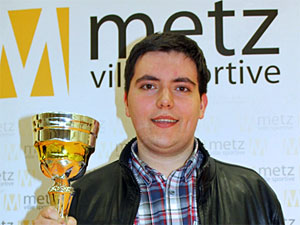


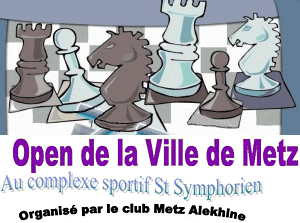
|
The 33rd Open de la Ville De Metz took place from April 20 to 26, 2015 in the city of Metz, France. The nine-round tournament was divided into two sections: Category A for players 1900 and above and Category B for players 2000 and below. Time controls: one hour and 30 minutes for 40 moves, 30 minutes added after that, and a 30 second increment from move one. Being a seven-day event meant there were two double round days and five days of single games. The prize fund of €10,000 with the first prize of €2500 was guarantte in case of 120 players participating in the A and B categories. As there were only 100 players (38 in A group and 62 in B) the prizes were reduced and the first prize of the ‘A’ category was revised to €2080. |
The beauty of Earth is that there so many different landscapes. The beauty of being a chess player is that you get to visit them while playing your favourite game. After the hot and arid terrain of the Middle East, Dubai, we (me and my wife) continued our journey westward. Boarding an Etihad airliner and travelling for nearly eight hours, we reached what is dubbed as the most romantic city in the world.

From the land of Burj Khalifa, the tallest building in the world [image: Wiki], we travelled to…

… Paris, which hosts the Eiffel Tower, the most visited monument in the world.
You can use your mouse key to browse around
the Eiffel Tower in this Google Street View map.
Approach the tower and look up – that is what we did when we were
in Paris.
But our journey was not yet complete. Taking a TGV from Paris we covered the distance of 300 kilometres in an hour and reached a small city in the north eastern part of France which is located at the confluence of the Moselle and Seille rivers, near the borders of three different countries: Luxembourg, Belgium and Germany.

A train that can reach 574.8 kmh (or 357.2 mph)
– but unimaginatively named "Train à Grande Vitesse".
Seriously, "Train with Great Speed"? They couldn't come up with bullet
or lightening or something catchier?

The city is filled lush greenery, water bodies and historical structures
For the fear that I might lose myself in showing the readers the beauty of this city and forget about the tournament, I am going to reserve the pictorial impressions of Metz for the part II report. For now let us focus on the 33rd Open de la Ville De Metz.

The winner of the event: 24 years old, Vladimir Onischuk (2651) from Ukraine
To give you an impression of the hunger and the ambitions of this young Ukrainian, he won the tournament with a phenomenal score of 8.0/9, two points clear of his nearest rival, with a massive rating performance of 2844. If you thought that the competition at this tournament was easy, think again. From the 38 players who took part, 23 were rated above 2300. There were nine grandmasters, one woman grandmaster and nine International Masters.

The 2500+ club (left to right): GMs Sergei Azarov, Dmitry Svetushkin, Vladimir Onischuk, Nikita Maiorov, Andrey Vovk, Evgeniya Doluhanova, Evgeny Romanov, the main organizer Salvatore Centonze, IMs Dennis Wagner, Alexander Doncehnko, Matthias Blübaum and Jacek Stopa. (Picture by Pierre Becker)
What made Onischuk’s victory even more brilliant was the fact that he had lost the second round game to IM Jacek Stopa. From round three, the lad was unstoppable, scoring seven consecutive victories. His scalps included IM Alexander Donchenko, IM Sagar Shah, IM Dennis Wagner, GM Dmitry Svetushkin, GM Vladimir Epishin and GM Evgeny Romanov.
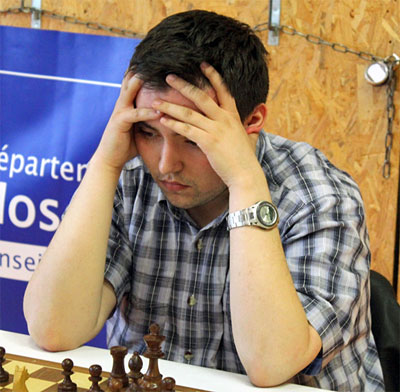
Vladimir Onischuk: the future hope of Ukrainian chess?!
Onischuk’s style of play is quite unusual. Unlike many of the youngsters of his age, Onischuk’s opening repertoire is pretty narrow. With the white pieces he often plays not the most ambitious setups, preferring solid lines like the Rossolimo against the Sicilian. With black he plays lines verging on the edges of dubiousness, like the Pirc against 1.e4 and 1…d6 or 1…g6 against the Queen Pawn Opening. That being said, opening is not where his strengths lie. It’s the middlegame and endgame. He calculates precisely, doesn’t get into time trouble and has superb technique. A look at his games from the Mega Database will assure you that once he gets a small edge he will most certainly convert his advantage, even against strong GMs. His performances of second place at the Capelle-La-Grande 2015 and third at Al-Ain Classic 2014 testify to his strength. With a rating of 2651 and gaining many Elo points from this event, we can safely predict an extremely bright future for Onischuk.
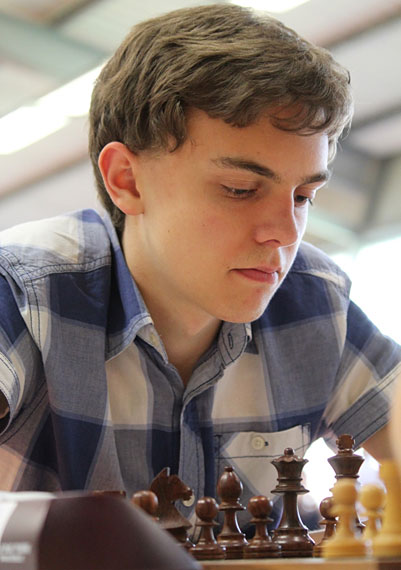
IM Dennis Wagner (2544) from Germany finished second with 6.0/9
This is definitely the last ChessBase report about “IM” Dennis Wagner – henceforth it will be GM! He might already have received his grandmaster title at the FIDE meet which is being held in Chengdu, China from the 26th-29th April. Dennis started the tournament with great energy. With wins over Azarov, Epishin and Stopa in rounds two, three and four he had already opened up a point’s lead over the rest. But then he met his nemesis in Vladimir Onischuk in round six. A grandiose battle took place between the two, and Dennis was kind enough to annotate this game in great depth for us, in spite of being on the losing side. Please pay close attention to the double queen “sacrifice” on back to back moves on the g4 square in the middlegame by the young German! Also on show was the resourcefulness of Onischuk and his will to win.

[Event "Metz 2015"] [Site "?"] [Date "2015.04.23"] [Round "6"] [White "Wagner, Dennis"] [Black "Onischuk, Vladimir"] [Result "0-1"] [ECO "A35"] [WhiteElo "2544"] [BlackElo "2651"] [Annotator "Dennis Wagner"] [PlyCount "130"] [EventDate "2015.??.??"] 1. d4 d6 2. Nf3 g6 3. c4 Bg7 4. Nc3 Bg4 5. e3 c5 {An interesting, but rather risky opening concept.} (5... Nf6 {is an alternative.}) 6. Be2 cxd4 7. exd4 Nc6 8. O-O Nh6 {Black´s main idea: the knight is heading for f5, putting pressure on White´s centre.} (8... Nf6 9. d5 Bxf3 10. Bxf3 Ne5 11. Be2 $14) 9. d5 Bxf3 10. Bxf3 Ne5 11. Be4 $1 {preventing Black´s idea, but inviting counterplay connected with the march of the f-pawn.} O-O (11... Nxc4 $2 12. Qa4+) 12. b3 f5 $1 13. Bc2 f4 14. Ne4 $1 {Very consistent. The knight is heading for e6, not fearing any material losses along the long diagonal.} (14. Ne2 $1 {is another route for the knight and might be even stronger.} f3 (14... Nf3+ 15. gxf3 Bxa1 16. Nxf4 $14) 15. Nf4 fxg2 16. Kxg2 Nf3 (16... Qd7 17. Ne6 $16) 17. Ne6 Qd7 ( 17... Qb6 18. Be3) 18. Rb1 $16) 14... Rf5 $5 (14... Nf3+ 15. Qxf3 Bxa1 16. Ng5 $36 {and}) (14... Nxc4 15. Rb1 Ne5 16. Ng5 $36 {seems to be rather dangerous.}) 15. Bd2 Qb6 {The queen is somewhat misplaced on b6, but it prevents f3 by White.} (15... f3 $5 16. Ng5 Rxg5 $5 17. Bxg5 Qd7 18. h3 $1 Nf5 19. Be4 $14) ({ or} 15... Qd7 16. f3 $14) 16. Rc1 Raf8 17. c5 $1 Qd8 (17... dxc5 $2 18. Nxc5 Qxc5 19. Bxf5 $18) 18. Bb1 $2 {preparing c6, but this is too slow.} (18. b4 f3 $1) (18. Re1 $1 {turns out to be a useful move. It neutralizes f3-ideas, because now the rook cannot be attacked by a pawn coming to g2.} Qd7 (18... f3 19. Ng5 fxg2 20. Bxf5 $18) 19. f3 Rh5 20. cxd6 exd6 21. Nf2 Nf5 22. Bxf5 Rhxf5 23. Bc3 $16) (18. f3 Rh5 19. Kh1 Nd7 $1 {a strong regrouping.} (19... g5 20. g4 $1 $16) (19... Nf5 20. Bxf4) 20. b4 Be5 21. Qe2 Nf5 $132) 18... Rh5 $5 (18... f3 $1 {Black already takes over the initiative.} 19. Ng5 fxg2 20. Kxg2 dxc5 $1 21. Rxc5 Qd6 $1 22. Bxf5 Nxf5 $36) 19. c6 bxc6 20. dxc6 f3 $2 ({During the game I was more afraid of} 20... Qc8 $1 {because after} 21. f3 {it´s just possible to take the pawn.} (21. c7 $2 f3 $19) 21... Nxc6 $1 22. Qc2 Bd4+ 23. Kh1 (23. Nf2 $1 Rc5 24. Qd3 {is necessary, with a slightly worse but holdable position.}) 23... Qf5 $1) 21. Ng3 Rxh2 $1 {This came as a big surprise to me, and should objectively be incorrect, but it offers great practical chances, especially in approaching time trouble.} (21... Rh4 22. Bg5 $18 {is just bad.} Rg4 (22... fxg2 23. Kxg2 Rg4 24. Qd5+ Nhf7 25. f4) 23. c7 Qa8 24. Bxe7 fxg2 25. Be4 $1 gxf1=Q+ 26. Kxf1 $18) 22. Kxh2 Nhg4+ 23. Kg1 e6 $1 {opening the way for the queen to join the attack.} 24. gxf3 (24. Bf4 $2 Rxf4 25. c7 Qh4 $1 26. c8=Q+ Rf8 27. Qxe6+ Kh8) (24. Nf5 $3 {opening the way for the bishop to f4, was a great ressource, securing a big advantage and probably winning the game.} gxf5 (24... Rxf5 25. Bxf5 $1 Qh4 26. Bxe6+ Kf8 (26... Nf7 27. Bxf7+) 27. Bf4 $18) (24... exf5 25. c7) 25. c7 Qa8 $1 {is necessary, but this should be winning for White anyway.} 26. g3 d5 27. Re1 $18) 24... Rxf3 $3 {allowing the white c-pawn to queen, but keeping the attack alive.} (24... Nxf3+ 25. Kg2 Nh4+ 26. Kh3 Nf3 27. Bf5 $3 Qh4+ 28. Kg2 exf5 29. Rh1 $18) (24... Qh4 25. fxg4 Nxg4 26. Qxg4 $1 Qxg4 27. Rc4 $18) 25. c7 Qh4 26. c8=Q+ Rf8 $1 (26... Bf8 27. Qxe6+ Kh8 28. Qxg4 Nxg4 29. Kg2 $1 Rf6 30. f4 $18) 27. Qxe6+ (27. Qxg4 Nxg4 28. Qxf8+ Bxf8 29. Kg2 Qh2+ 30. Kf3 Qh3 31. Rh1 Ne5+ 32. Ke2 Qg4+ 33. Kf1 d5 {is quite unclear.}) 27... Kh8 {A picturesque position} 28. Qexg4 $1 Nxg4 29. Qxg4 $1 Qxg4 {A very nice double(!) queen sacrifice allowed White to repell the attack and keep some edge in a complicated material construction.} 30. Bc3 $2 {A bad strategical mistake, handing the initiative again over to Black. White should keep more pieces in order to make it harder for the queen to molest the white king.} (30. Rc4 $1 $16 {The only move keeping the edge and good winning chances, because} Bd4 {is not possible on account of} (30... Qd7 31. Ra4 $16) ( 30... Qh3 31. Be4 $1 {creating pleasant harmony in the white camp.}) 31. Be3 $1 $18) 30... h5 $1 (30... Bxc3 31. Rxc3 h5 32. Rc4 Qg5 33. Kg2 $1 {was what I had relied on}) 31. Bxg7+ Kxg7 32. Rc4 Qg5 (32... Rf4 $5 $15) 33. Kh1 d5 $6 ( 33... Rf4 $5 $15 {It´s very important to exchange that rook.}) (33... Qxg3 34. Rc7+ Kh6 35. fxg3 Rxf1+ 36. Kg2 Rxb1 37. Rxa7 $11) 34. Rd4 $2 (34. Ra4 $1 { Keeps the balance.} h4 (34... Rf4 35. Rxa7+ $11) 35. Nf5+ $1 Rxf5 36. Bxf5 Qxf5 37. Rxh4 $11) 34... Rf4 35. Rxf4 Qxf4 36. Rg1 Qf3+ 37. Rg2 (37. Kh2 Qxf2+ 38. Rg2 Qf4 $19) 37... h4 (37... Kf6 $1 $19 {is a better technical solution.}) 38. Nf5+ Kf8 39. Nxh4 Qh3+ 40. Kg1 Qxh4 41. Bxg6 Qd4 42. Rg3 {I had hoped to set up a fortress here, but this turns out to be very difficult.} Qa1+ 43. Kg2 Qxa2 44. Re3 $2 {The only chance of survival is pushing the b-pawn to b5, where it can be protected securely by a bishop on f1, while the rook is controlling the whole third rank.} (44. Rf3+ $1 Ke7 (44... Kg7 45. Bf7 d4 (45... Qd2 46. Be8 d4 47. Bb5 $1) 46. Bc4 {Now the black king is cut off from the queenside, so it is difficult to break through.} a5 47. Bf1 (47. Rf7+ Kh6 48. Rf3 a4) 47... Qc2 48. Bb5 Qe4 49. Bd3 Qc6 50. Bf1 Kg6 51. Be2 Kg5 52. Bd3 Kg4 53. Bf5+ Kh4 54. Bd3) 45. b4 $1 {This is only possible in this concrete situation, because the king is placed badly on e7.} Qa4 $1 (45... Kd6 46. b5 d4 47. Bd3 Kc5 48. Bf1 $11 {should be an easy draw.}) 46. b5 Qxb5 (46... Kd6 47. Bd3 Qd1 48. Rg3 Kc5 49. Bf1 d4 50. Bd3 Kb4 51. Bf1) 47. Rf7+ $1 {the point} Ke6 48. Rxa7 {Now it´s somehow impossible to exploit the bad coordination of the white forces.} Kf6 $1 {the best try} (48... d4 49. Ra3 $1) (48... Qb4 49. Bf7+ $1 Kd6 50. Bxd5 Kxd5 51. Rg7 $1 $11) 49. Bh7 $1 (49. Bf7 d4 $19) 49... Qb4 $1 50. Ra6+ Ke5 51. Rg6 Qh4 52. Rg7 Qh6 53. Ra7 d4 54. Bd3 Qd2 55. Ra3 {White is still holding everything together.}) (44. b4 Qc4 $19) 44... Kg7 45. Bf5 Kf6 46. Bh7 d4 47. Rf3+ Ke5 $2 {misplacing the king and giving me the chance to play b4 again.} ( 47... Ke6 $1 $19) 48. Bg6 $2 (48. b4 $1 Qd5 (48... Qb2 49. b5 $1 Qxb5 $4 50. Rf5+ $18) 49. Bd3 $11) 48... Qa6 49. Rg3 Qc6+ 50. Kg1 Kd6 51. Bd3 Qc1+ 52. Bf1 Kc5 53. Rh3 Kb4 54. Rg3 a5 $19 {Now it´s just lost. The king will walk to e1 via a3, and the weakness of the f2 pawn will cause the collapse of the defence. } 55. Kg2 (55. Rh3 Qc3 $1 $19) 55... Qc6+ 56. Kh2 Ka3 57. Rh3 Kb2 58. Rg3 Kc2 59. Bc4 a4 60. Bd3+ Kxb3 61. Be4+ Qc3 62. f4 Kb4 63. Rxc3 dxc3 64. f5 Kc5 65. f6 Kd6 {This interesting game turned out to be a decisive clash, determining the future winner of the tournament.} 0-1

A great fighting game between two talented youngsters
After his loss to Onischuk, Dennis lost a further game to Romanov before striking back in the last round to beat the top seed Andrey Vovk (2654) and finish second.

German Matthias Blübaum (2586) played consistently, remained unbeaten and finished third
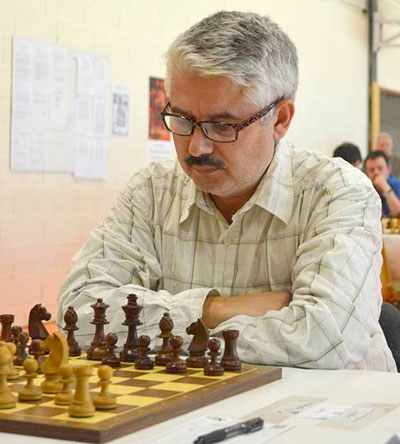
GM Stanislav Savchenko (2511) from Ukraine finished fourth [picture by Pierre Becker]
Stanislav Savchenko (not to be mistaken with Boris Savchenko) has not been playing much these days due to family commitments, but he was a strong player with a peak rating of 2590 in 2007. In his heydays he has drawn with absolute in elites like Anand, Svidler, Short, van Wely, etc., and that too in classical time controls.

IM Jacek Stopa (2537) from Poland, another player
who will be
receiving his GM title in a day or two, scored 5.5/9 and finished fifth
Jacek Stopa can be proud of the fact that he was the only player in the event who could inflict a defeat on the eventual winner, Vladimir Onischuk. This game has been annotated for us by Jacek in a very special way. You can play through the first 30 moves on the chess board, up to the diagram position, and then follow the nine minutes of instruction from the Polish grandmaster where he explains, in impeccable English, the thought process behind his next 17 moves.

[Event "Metz 2015"] [Site "?"] [Date "2015.04.21"] [Round "2"] [White "Onischuk, Vladimir"] [Black "Stopa, Jacek"] [Result "*"] [ECO "C70"] [WhiteElo "2651"] [BlackElo "2537"] [PlyCount "104"] [EventDate "2015.??.??"] 1. e4 e5 2. Nf3 Nc6 3. Bb5 a6 4. Ba4 Nge7 5. Bb3 d5 6. Nc3 Be6 7. Ng5 Nd4 8. d3 Qd6 9. O-O Nxb3 10. axb3 d4 11. Nb5 Qd7 12. Nxe6 fxe6 13. Na3 Nc6 14. Nc4 b5 15. Nd2 Bd6 16. Qh5+ Qf7 17. Qh3 O-O 18. Nf3 h6 19. Bd2 a5 20. Qg4 Qf6 21. h4 Ra6 22. h5 Bb4 23. Bc1 Be7 24. Qg3 Kh7 25. Bd2 g6 26. hxg6+ Qxg6 27. Qxg6+ Kxg6 28. Rfb1 h5 29. Kf1 Rfa8 30. Ke2 {[#]The next part of the game is explained by IM Jacek Stopa in the Youtube video below this game.} a4 31. g4 hxg4 32. Rg1 axb3 33. Rxg4+ Kf7 34. Rh1 bxc2 35. Rh7+ Ke8 36. Rgg7 Kd8 37. Bc1 Ra1 38. Kd2 Kd7 39. Nxe5+ Nxe5 40. Rxe7+ Kd6 41. Rxc7 Rf8 42. Kxc2 Rxf2+ 43. Bd2 Rg1 44. Rc8 Nf3 45. Rd8+ Ke5 46. Rh5+ Kf6 47. e5+ Ke7 48. Rdh8 Rxd2+ 49. Kb3 Kf7 50. R8h6 Rg5 51. Rh7+ Kg6 52. R5h6+ Kf5 *

– More from the Metz Open in a second report to follow soon –